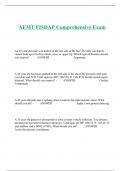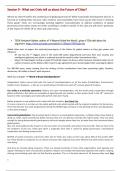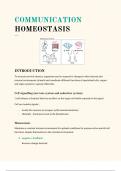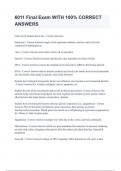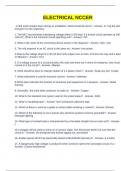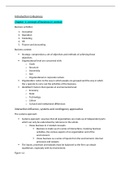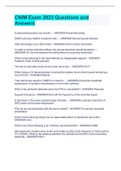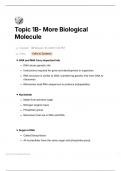ARISTOTLE’S FALLACY
According to Aristotelian law an external force is required to keep Third law : To every action there is an equal and opposite
a body in motion. However an external force is required to reaction. For example – walking , swimming , a horse pulling a
overcome the frictional forces in case of solids and viscous forces cart etc.
r r
in fluids which are always present in nature. FAB = – FBA
LINEAR MOMENTUM (p) Action and reaction act on different bodies and hence cannot
Linear momentum of a body is the quantity of motion contained balance each other. Action and reaction occur simultaneously.
r r Forces always occur in pairs.
in the body. Momentum p = mv
It is a vector quantity having the same direction as the direction EQUILIBRIUM OF A PARTICLE
of the velocity. Its SI unit is kg ms–1. A body is said to be in equilibrium when no net force acts on the
body.
NEWTON’S LAWS OF MOTION r
i.e., SF = 0
First law : A body continues to be in a state of rest or of uniform
motion, unless it is acted upon by some external force to change Then SFx = 0, SFy = 0 and SFz = 0
its state. Stable equilibrium : If a body is slightly displaced from equilbrium
Newton’s first law gives the qualitative definition of force according position, it has the tendency to regain its original position, it is
to which force is that external cause which tends to change or said to be in stable equilibrium.
actually changes the state of rest or motion of a body.
Newton’s first law of motion is the same as law of inertia given by æ d 2u ö
In this case, P.E. is minimum. ç 2 = +ve ÷
Galileo. ç dr ÷
è ø
Inertia is the inherent property of all bodies because of which
So, the centre of gravity is lowest.
they cannot change their state of rest or of uniform motion unless
Unstable equilibrium : If a body, after being displaced from the
acted upon by an external force.
equilibrium position, moves in the direction of displacement, it is
Second law : The rate of change of momentum of a body is directly
said to be in unstable equilibrium.
proportional to the external force applied on it and the change
takes place in the direction of force applied. æ d 2u ö
In this case, P.E. is maximum. ç 2 = -ve ÷
r dpr mdvr r ç dr ÷
i.e., F = = = ma è ø
dt dt So, the centre of gravity is highest.
This is the equation of motion of constant mass system. For Neutral equilibrium : If a body, after being slightly displaced
variable mass system such as rocket propulsion from the equilibrium position has no tendency to come back or to
r d ( mvr ) move in the direction of displacement the equilibrium is known to
F= be neutral.
dt
æ d 2u ö
r m(dvr ) r dm In this case, P.E. is constant ç 2 = constant ÷
And, F = +v ç dr ÷
dt dt è ø
The SI unit of force is newton. (One newton force is that much The centre of gravity remains at constant height.
force which produces an acceleration of 1ms–2 in a body of mass COMMON FORCES IN MECHANICS
1 kg. 1. Weight : It is the force with which the earth attracts a body
The CGS unit of force is dyne. (1N = 105 dyne) and is called force of gravity, For a body of mass m, where
The gravitational unit of force is kg-wt (kg-f) or g-wt (g-f) acceleration due to gravity is g, the weight
1 kg-wt (kg-f) = 9.8 N, 1 g-wt (g-f) = 980dyne W = mg
, EBD_7751
100 PHYSICS
2. Tension : The force exerted by the ends of a loaded/stretched
string (or chain) is called tension. The tension has a sense
of pull at its ends. Case 3
q N
Case 1 Case 2 mg sinq mg cos q
2T mg
T
2T
T Massless N = mg cos q
T T pulley q
T T
m1 m2 4. Spring force : If an object is connected by spring and spring
m1g m2g is stretched or compressed by a distance x, then restoring
force on the object F = – kx
Case 3 where k is a spring contact on force constant.
T T a 5. Frictional force : It is a force which opposes relative motion
T' T' T1
T between the surfaces in contact. f = mN
T m
T1 – T = ma This will be discussed in detail in later section.
T
If m = 0, T1 = T 6. Pseudo force : If a body of mass m is placed in a non-inertial
i.e tension is same frame having aceleration ar , then it experiences a Pseudo
The tension in a string remains the same throughout the string if r
force acting in a direction opposite to the direction of a .
(a) string is massless, r r
(b) pulley is massless or pulley is frictionless Fpseudo = – ma
Case 4 : String having mass Negative sign shows that the pseudo force is always directed
in a direction opposite to the direction of the acceleration of
the frame.
y
Let the total mass of the string be M and length be L. Then mass a
Fpseudo
per unit length is
M m x
L
Let x be the distance of the string from the mass m. Then the mass z
æM ö CONSTRAINT MOTION :
of the shaded portion of string is ç ´ x ÷ When the motion of one body is dependent on the other body, the
è L ø
relationship of displacements, velocities and accelerations of
If the string is at rest then the tension T has to balance the wt of
the two bodies are called constraint relationships.
shaded portion of string and weight of mass m.
Case 1 Pulley string system :
æ M ö
\T = çm + x÷ g
è L ø X
Þ as x increases, the tension increases. Thus tension is non- F
uniform in a string having mass.
3. Normal force : It measures how strongly one body presses x Block
the other body in contact. It acts normal to the surface of
contact. Step 1 : Find the distance of the two bodies from fixed points.
Step 2 : The length of the string remain constant. (We use of
mg
Case 1 N = mg this condition)
N Therefore X + (X – x) = constant Þ 2X – x = constant
Case 2 dX dx dX dx
Þ 2 – =0 Þ 2 =
a N – mg = ma dt dt dt dt
m mg Þ N = m(g + a)
é dX
Þ 2Vp = v B êQ = Vp = velocity of pulley
N ë dt
, Laws of Motion 101
dx ù When the observer is in non-inertial reference frame a
= v B = velocity of block ú pseudo force is applied on the body under observation.
dt û
Again differentiating we get, 2ap = aB Free Body Diagram (FBD) :
é dVp dvB ù Free body diagram of a mass is a separate diagram of that mass.
êa p = dt and a B = dt ú All forces acting on the mass are sketched. A FBD is drawn to
ë û
visualise the direct forces acting on a body.
ap = acceleration of pulley, aB = acceleration of block Case 1 : Masses M1 and M2 are tied to a string, which goes over
2 2 a frictionless pulley
Case 2 Here h + x + y = constt. On differentiating w.r.t ‘t’
(a) If M2 > M1 and they move with acceleration a
y
h
T
1 q 2 a T
F M1
x a
[Negative sign with dy/dt shows that with increase in time, y M1g M2
decreases]
1´ 2x dx dy
- = 0 Þ cos q (v1 – v2) = 0 M2g
2 h 2 + x 2 dt dt FBD of M1, FBD of M2
é x ù T T
êQ cos q = ú
ëê h 2 + x 2 ûú
M1 a M2 a
Case 3 Wedge block system : Thin lines represents the condition
of wedge block at t = 0 and dotted lines at t = t
M1g M2g
c T - M1g = M1a M 2g - T = M 2a
ax where T is the tension in the string. It gives
ay ay M 2 - M1 2M 1 M 2
a= g and T = g
q M1 + M 2 M1 + M 2
B ax Ax A (b) If the pulley begins to move with acceleration f,
Ax
q downwards
Ax = acceleration of wedge towards left uur M - M uur uur ur 2 M M uur uur
a = 2 1 ( g - f ) and 1 2
ax, ay = acceleration of block as shown T = (g - f )
M1 + M 2 M1 + M 2
ay Case 2 : Three masses M1, M2 and M3 are connected with strings
From D ABC , tan q =
ax + Ax as shown in the figure and lie on a frictionless surface. They are
Frame of Reference : pulled with a force F attached to M1.
Reference frames are co-ordinate systems in which an event is T2 T2 T1 T 1
M3 M2 M1 F
described.
There are two types of reference frames The forces on M2 and M3 are as follows
(a) Inertial frame of reference: These are frames of reference
in which Newton’s laws hold good. These frames are at rest M 2 + M3 M3
T1 = F and T2 = F;
with each other or which are moving with uniform speed M1 + M 2 + M 3 M1 + M 2 + M 3
with respect to each other.
All reference frames present on surface of Earth are F
Acceleration of the system is a =
supposed to be inertial frame of reference. M1 + M 2 + M 3
(b) Non – inertial frame of reference: Newton’s law do not
Case 3 : Two blocks of masses M1 and M2 are suspended
hold good in non-inertial reference frame.
All accelerated and rotatory reference frames are non – vertically from a rigid support with the help of strings as shown
inertial frame of reference. Earth is a non-intertial frame. in the figure. The mass M2 is pulled down with a force F.
, EBD_7751
102 PHYSICS
T1 y
R=N T x
T1
M1 g M1
T2 M1g cos q
T2 M1g sin q M1g
M2g
M2 FBD of M2
é M M ù g
F T =ê 2 1 ú
ë M1 + M2 û (1+sin q) T a
The tension between the masses M1 and M2 will be
M2g
T2 = F + M2g
Tension between the support and the mass M1 will be (ii) When the mass M 1 moves downwards with
T1 = F + (M1 + M2)g
Case 4 : Two masses M1 and M2 are attached to a string which acceleration a.
passes over a pulley attached to the edge of a horizontal table. Equation of motion for M1 and M2,
The mass M1 lies on the frictionless surface of the table. M1g sin q – T = M1a ...(1)
T T – M2g = M2a ...(2)
M1 Solving eqns. (1) and (2) we get,
a é M sin q - M 2 ù é M 2 M1 ù g
T a=ê 1 ú g; T = ê ú
ë M1 + M 2 û ë M1 + M 2 û (1 + sin q)
M2 (a) If (M2/M1 = sinq) then the system does not accelerate.
M2 g (b) Changing position of masses, does not affect the
tension. Also, the acceleration of the system remains
Let the tension in the string be T and the acceleration of the unchanged.
system be a. Then
T = M1a ...(1) (c) If M1 = M2 = M (say), then
M2g – T = M2a ...(2) 2 2
Adding eqns. (1) and (2), we get æ q qö æ g ö æ q q ö æ Mg ö
a = ç cos - sin ÷ ç ÷ ; T = ç cos + sin ÷ ç ÷
è 2 2ø è 2 ø è 2 2ø è 2 ø
é M2 ù é M1 M 2 ù
a=ê ú g and T = ê úg Case 6 : Two masses M1 and M2 are attached to the ends of a
ë M1 + M 2 û ë M1 + M 2 û
string over a pulley attached to the top of a double inclined
Case 5 : Two masses M1 and M2 are attached to the ends of a
string, which passes over a frictionless pulley at the top of the plane of angle of inclination a and b.
inclined plane of inclination q. Let the tension in the string be T. Let M2 move downwards with acceleration a and the tension in
the string be T then
N
M1 M1 M2
q M2
M1g sinq M1g cosq
M1g a b
M2g
q
FBD of M1 a
T
(i) When the mass M1 moves upwards with acceleration a.
M1
From the FBD of M1 and M2,
T – M1g sin q = M1a ...(1) a
na M1gcosa
M2g – T = M2a ...(2) gsi M1g
Solving eqns. (1) and (2) we get, M 1
é M - M1 sin q ù Equation of motion for M1
a=ê 2 úg T – M1g sin a = M1a
ë M1 + M 2 û or T = M1g sin a + M1a ...(1)
FBD of mass M1

